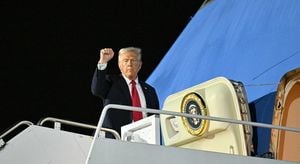Recent developments concerning US steel and aluminum tariffs have ignited concerns among Indian steel producers. President Donald Trump has announced plans to impose 25% tariffs on all steel and aluminum imports, which could complicate the export dynamics for countries like India.
Speaking to the press over the weekend, Trump revealed his intention to implement these new tariffs shortly, alongside potential reciprocal tariffs aimed at countries imposing duties on American products. While India does not rank among the largest exporters of steel to the US—sending about $3 billion worth annually—experts warn of wider repercussions stemming from Trump's protectionist policies.
Historically, similar measures during Trump's previous administration resulted in increased protectionist tariffs globally, adversely affecting Indian steel exports. This cascading effect was caused by fears of diverted Chinese steel exports, which led to restrictions from the European Union and other regions. Consequently, Indian markets found themselves flooded with cheap steel imports.
Data from India's steel ministry confirms this unsettling trend, noting imports surged to 5.51 million tonnes between April and September of 2024-25, up from 3.66 million tonnes during the same timeframe the previous year. Imports from China alone rose from 1.02 million tonnes to 1.85 million tonnes, indicating growing reliance on foreign steel sources.
Global rating agency Moody’s has articulated concerns about the looming challenges for Indian steel manufacturers. According to Hui Ting Sim, assistant vice president at Moody's, "The US tariffs on steel will increase competition and exacerbate oversupply at other steel producing markets. Indian steel producers will face increased challenges in exporting their products." Such assessments paint a precarious picture for Indian exporters already grappling with low prices and diminishing profit margins.
Further illustrating the situation, Ajay Srivastava, founder of the Global Trade Research Initiative (GTRI), remarked on the tactical precedent set by past tariff policies. "If Trump follows the same playbook, the return of tariffs on steel and aluminium could be used as leverage in trade negotiations," he warned, adding the likelihood of escalated trade disputes could arise from affected nations seeking retaliation.
Despite the worrying forecasts, Indian officials express optimism about the strength of their domestic market. Steel Secretary Sandeep Poundrik noted during remarks at the Bengal Chamber of Commerce and Industry: "The domestic market itself is strong enough because of the growing consumption, which, in upcoming years, the steel industry will find difficult to cater to." He emphasized the low volume of US-bound exports—citing only 95,000 tonnes out of India's production of 145 million tonnes last year—as not particularly impactful.
Trump’s new tariff initiative could benefit US steel producers by creating a favorable pricing environment as they regain control of the supply chain. This scenario is similar to previous tariff impositions where domestic industries capitalize on reduced foreign competition.
Reflecting on the past trade tensions, it’s reminiscent of 2018 when tariffs of 25% on steel and 10% on aluminum were introduced, leading to retaliatory measures such as India imposing additional customs duties on various US goods. Just recently, on July 3, 2023, the US had removed tariffs after extensive negotiations between India and the US during Prime Minister Narendra Modi's visit to Washington.
Looking forward, the return of such tariffs could reignite hostilities reminiscent of prior trade wars. Analysts like Srivastava caution, "If history repeats itself, the US steel and aluminium industries may benefit in the short term, but global trade frictions could intensify, with lasting economic consequences." Such sentiments resonate across the international trade arena, especially for nations like India trying to navigate complex tariff landscapes.
With the situation still developing, the potential for new trade disputes looms large, leaving Indian steel manufacturers and exporters bracing for effects rippling from Trump's administration's latest trade policy decisions. Whether these tariffs signal merely the start of renewed trade tensions or mark the beginning of growing global trade complications remains to be seen.



